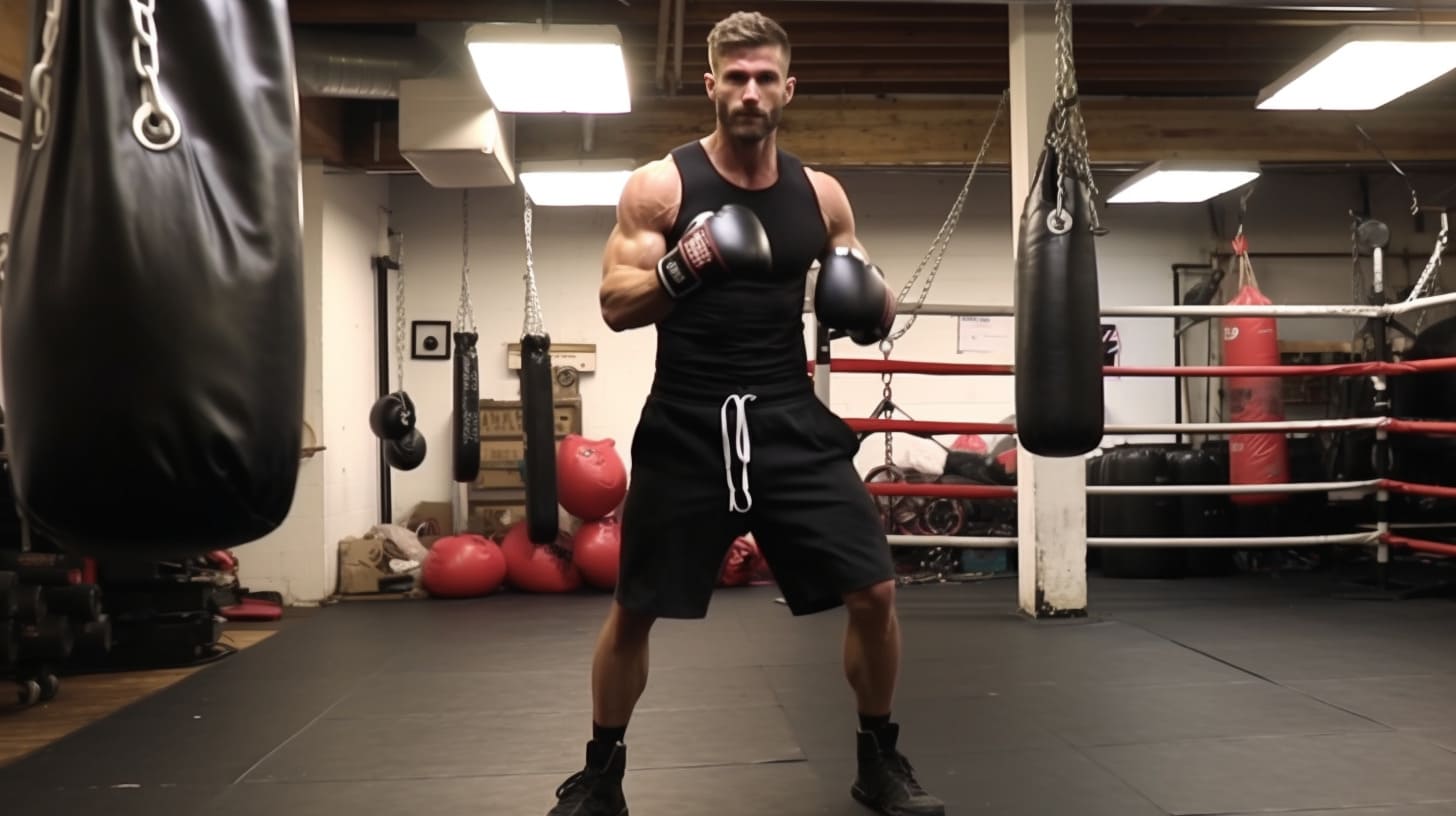When you hear the term “southpaw boxing style,” it conjures images of legendary left-handed fighters weaving and striking with a finesse that seems to defy conventional boxing wisdom. In essence, a southpaw fighter stands with their right hand and right foot forward, which differs from the more common orthodox stance where the left hand and left foot lead. This unique positioning gives southpaws certain strategic advantages in the ring, including the element of surprise and a different angle of attack that can baffle orthodox opponents. Let’s delve into what makes the southpaw stance a fascinating and formidable style in the boxing world.
What Is Southpaw Boxing Style?
Ever wondered why some fighters seem to stand ‘backwards’ in the ring? That’s the southpaw stance — a unique and strategic approach to boxing that flips the script on conventional fighting styles. Let’s dive into what makes a southpaw fighter tick and how it shakes up the boxing world.
The Stance and Footwork
The southpaw stance is all about the art of mirror imaging. Southpaw fighters stand with their right foot and hand forward, as opposed to the left in the traditional orthodox posture. So, why all the switcheroo? It’s all about advantage and angle.
- Stance Principles:
- The right hand (the jab hand for southpaws) is closer to the opponent, making it quicker to land a jab.
- The dominant left hand is in the back, allowing for more powerful crosses and hooks.
- Footwork Techniques:
- Southpaws aim to keep their right foot outside of an orthodox opponent’s left foot to dominate the angle and create a direct path for the left hand.
- Fluid lateral movement is key to maintain the stance advantage and to set up striking opportunities.
The Guard and Defense
Just like their orthodox counterparts, southpaw boxers keep their hands up to protect the face and body. But here’s the twist — because of their stance, their guarding strategy needs to counter moves coming from angles that are more common in orthodox vs. southpaw matchups.
- Guarding Tactics:
- The right hand, being more forward, is primarily used to parry jabs and hooks.
- The left hand guards against right crosses and sets up counter-hooks and uppercuts.
Style Differences and Matchup Quirks
Southpaw fighters don’t just stand differently; they make the whole dance of boxing a distinctive routine. Facing a southpaw can throw an orthodox fighter off their game because punches come from unexpected directions.
- Key Southpaw Differences:
- Their jab comes from the right, creating a crossfire with an orthodox fighter’s jab.
- The power punch (left cross) travels less distance and can catch an opponent by surprise.
- Unconventional angles and footwork can create confusion and openings.
- Strategies for Success:
- Southpaws often exploit their rarity; many fighters are less accustomed to facing left-handed opponents.
- They adapt by mirroring their opponent’s movement and seeking to control the pace and range of the fight.
In conclusion, the southpaw boxing style flips the script on traditional techniques, offering a fresh and sometimes confusing challenge to the orthodox-dominated ring. Understanding this stance uncovers a layer of strategy that’s as much about psychology as it is about punches. Keep your eye on the ring’s mirror image, and watch how southpaw boxers dance to a rhythm all their own.
Signature Moves & Strategies in Southpaw Boxing

Ever wondered why southpaws seem to have that extra edge in the ring? It’s all in their unique moves and strategies. Let’s break down the top three tactics that give southpaws their distinct advantage and watch how they turn the tide in a fight.
1. Right Hook
The right hook from a southpaw stance is a crafty little number. Since it comes from the southpaw’s lead hand, it can catch orthodox fighters off guard, often slipping past their defenses. This is because orthodox fighters are generally less used to defending against lead-hand power punches. One southpaw who turned the right hook into an art form is none other than Manny Pacquiao. His explosive lead hook has toppled numerous opponents and is a fundamental element of his offensive arsenal.
- Quick Execution: Catches opponents by surprise.
- Lead Hand Power: Opposite of what orthodox fighters are used to.
- Element of Surprise: Great for breaking through an opponent’s guard.
2. Straight Left
The straight left punch is the bread and butter for southpaws—it’s their power punch. Delivered from the back hand, it goes straight down the pipe and can be devastating due to the angle and distance it travels. A prime example is when Vasyl Lomachenko, with his impeccable footwork, uses the straight left to do significant damage. It’s a punch that is often set up by clever lead-hand jabs.
- Powerful Impact: Devastating when it lands clean.
- Longer Reach: Takes the most direct path to the target.
- Effective Counter: Works well against an advancing opponent.
3. Foot Positioning
Alright, this might not sound like a ‘move,’ but trust me, footwork in southpaw boxing is a key strategy. The constant battle for outside foot positioning against an orthodox opponent gives the southpaw strategic control over the fight. Getting the lead foot outside the opponent’s lead foot creates angles for attacks and can make the orthodox fighter more vulnerable. Marvelous Marvin Hagler showed the world just how effective this tactic can be.
- Control the Angles: Creates advantageous positions for attack.
- Defensive Advantages: Helps in evading incoming punches.
- Strategic Movement: Dictates the pace and flow of the bout.
These signature moves and tactics aren’t just for show—they’re time-tested strategies that use the southpaw stance to outmaneuver and outpunch the competition. Next time you watch a southpaw in action, keep an eye out for these techniques and see how they control the ring with that wicked left hand and some smart stepping.
Challenges and Limitations

Let’s face the music: the southpaw boxing style isn’t all sunshine and rainbows. It’s a unique stance that can throw off orthodox fighters, sure, but it comes with its own set of hurdles. Here’s the lowdown on some situations where southpaws might find themselves up against the ropes.
- The Mirror Effect: When two southpaws square off, it’s like looking in a mirror — the advantage of being ‘unusual’ is neutralized.
- Limitations in Training: Finding sparring partners and coaches who are savvy with the southpaw style can be as tough as nailing a perfect uppercut.
- Adaptability Issues: Some southpaw fighters struggle to adapt when plans go awry — and in boxing, plans often need a Plan B and C.
- Glove and Gear Troubles: Ever tried finding southpaw-friendly gear? It’s like a treasure hunt without the map.
The Benefits of the Southpaw Boxing Style
When it comes to the southpaw stance, it’s like having a secret weapon in your back pocket that can surprise and unsettle your opponent. But like any good secret weapon, it has its time and place. Here are the times when southpaw shines brightest:
- Facing Orthodox Fighters: The angle of attack can really mess with a traditional fighter’s rhythm and defense.
- Striking From Unique Angles: Southpaws can sneak in punches from directions that orthodox fighters might not see coming.
- Defensive Maneuvers: Those right-leaning jabs? Southpaws can slide past them like they’re dodging raindrops.
- Psychological Edge: Just being a southpaw can get inside an opponent’s head — it’s like being a puzzle they’re not sure how to solve.
The Drawbacks of the Southpaw Boxing Style
Alright, let’s be real: sometimes, the very things that make the southpaw stance great can come back to bite you in the… well, let’s just say they can backfire. Here’s when you might wish you stood a little differently:
- Predictability Over Time: If you rely too much on the southpaw surprise, you’ll become a one-trick pony.
- Struggles with Inside Fighting: Getting up close and personal can put a southpaw at a disadvantage against a savvy orthodox brawler.
- Counterpunch Vulnerability: Some opponents are real wizards at countering that iconic southpaw lead right hand.
- Cross-Dominance Complications: For fighters who aren’t naturally left-handed, the southpaw stance can feel about as comfortable as a pair of itchy boxing gloves.
Whether you’re a southpaw yourself or just trying to get the hang of fighting one, remember that in boxing, knowledge is power — the power to duck, weave, and land the knockout punch when it counts. Keep these insights in your corner, and you’ll be ready to rumble!
Defending Against Southpaw Boxing Style

Got a southpaw in the ring? No sweat! Defending against a southpaw can feel like you’re trying to solve a crossword puzzle blindfolded. But with the right approach, you can crack the code. Southpaws can be as tricky as a curveball, thanks to their unorthodox stance that flips the script on traditional boxing angles.
Understanding Southpaw Challenges
To start off, it’s important to recognize the distinct challenges southpaws bring to the table. Their dominant hand is the left, which makes for some interesting encounters if you’re used to orthodox fighters. Let’s break down some practical tips to keep you light on your feet and ready to defend like a pro.
- Lead Foot Dominance: It’s all about footwork. Keep your lead (right) foot outside their lead (left) foot to control the pace and create favorable angles.
- Counter Their Strength: Their left hand is their bread and butter. Practice slipping and countering after they throw a left cross.
- Double Up on Defense: Southpaws can be slippery, so double your guard up against their straight left and hooks.
Here, take these additional golden nuggets of advice to fine-tune your defense strategy:
Additional Practical Tips
- Watch the Right Hook: Often, southpaws pack a surprise with a powerful right hook. Keep your left hand high to guard your temple and chin.
- Keeping your guard tight on your left side not only protects you from the unexpected right hook but also prepares you for a quick counter.
- Focus on Body Shots: Southpaws might guard their face well, but their body can be an open target.
- Digging in with right hands to the body can lower their guard and open them up for follow-up headshots.
- Employ Angles: Maneuvering to your right can fluster a southpaw. It moves you away from their power hand and lets you attack from the side.
- By circling away from the southpaw’s dangerous left, you decrease their chances of landing a power punch and you can throw them off their rhythm.
Alright, now that you’re armed with these tactics, step into the ring with confidence. Remember, practice makes perfect, so drill these strategies until they become second nature. Keep these tips in your back pocket, and you’ll be ready to sidestep the southpaw puzzle like a true champ.
Notable Practitioners

When we talk about boxing, the southpaw stance often comes with a sense of intrigue and respect. It’s a unique style that has been both a challenge and a weapon for those who have mastered it. There are a few legends in the boxing world who have not only excelled as southpaws but have also left an indelible mark on the sport with their unconventional approach. Let’s get to know three of these stand-out southpaws who have written their names into the history books with their left-handed wizardry.
1. Marvelous Marvin Hagler
Grit, power, and an iron chin — Marvelous Marvin Hagler’s name rolls off the tongue as easily as his punches rolled off his shoulders. Hagler, a fierce middleweight champion, reigned supreme during the 1980s, and his southpaw style was an integral part of his legend.
- Career and Achievements:
- Reigning as Undisputed Middleweight Champion from 1980 to 1987
- An impressive record of 62 wins (52 by knockout), 3 losses, and 2 draws
- Noteworthy Contributions:
- Known for his aggressive fighting and ability to switch hit, seamlessly changing between southpaw and orthodox to confuse opponents
- Memorable Fights:
- The epic battle with Tommy Hearns in 1985, known as “The War,” where Hagler’s southpaw stance helped him triumph in one of the most ferocious fights in boxing history.
2. Manny “Pac-Man” Pacquiao
A whirlwind of speed and agility, Manny Pacquiao, the pride of the Philippines, has been thrilling fans for decades with his explosive southpaw style.
- Career and Achievements:
- The only eight-division world champion in the history of boxing
- Garnering an amazing record with wins over some of the biggest names in the sport
- Noteworthy Contributions:
- Pacquiao’s lightning-fast left hand has become the stuff of legends, inspiring a new generation of boxers to embrace the southpaw stance
- Memorable Fights:
- His stunning demolition of Miguel Cotto in 2009, where his relentless southpaw offense proved too much for Cotto, is a highlight in a stellar career.
3. Pernell “Sweet Pea” Whitaker
Elegance and artistry defined Pernell Whitaker’s time in the ring. As a southpaw, he was a master of defense and counter-punching, making him one of the most difficult boxers to hit.
- Career and Achievements:
- A dominant lightweight champion and successful in multiple weight divisions
- A record of 40 wins (17 by knockout), 4 losses, 1 draw, and 1 no contest
- Noteworthy Contributions:
- Whitaker’s defensive prowess as a southpaw is still studied by boxers and coaches as the gold standard for elusiveness in the ring
- Memorable Fights:
- His bout against Julio César Chávez in 1993 showcased his incredible skill, as he outboxed one of the greatest fighters of the era, leading many to believe he deserved the victory in what was officially scored a draw.
These southpaw stylists not only triumphed over formidable opponents but they also showed the boxing world just how devastating and beautiful the left-handed stance can be. Each has contributed to the legacy of the southpaw style, offering up plenty of technique and tactics to be analyzed and admired by boxers for years to come.
Training and Conditioning for the Southpaw Boxing Style

Ah, the southpaw stance – the unconventional, the unexpected, the mirror image that can throw off any orthodox fighter in the ring. Whether you’re a lefty looking to capitalize on your natural stance or a right-hander aiming to surprise your opponents, adopting the southpaw boxing style can be a game-changer. Let’s get down to business and talk about conditioning and training tailored for southpaws.
Specific Drills for Southpaw Stance
First off, stance and footwork are everything for a southpaw. Being agile and able to control the distance between you and your opponent is your bread and butter.
- Mirror Drills: Face another southpaw and mimic their movements. This helps you understand the spatial dynamics unique to southpaw vs. southpaw.
- Pivot Drills: Focus on pivoting off your front foot. It allows you to create angles and openings for that lethal left hand.
- Shadowboxing: Emphasize throwing your left straight and left cross from different angles, helping you to establish dominance with your power hand.
Strength and Conditioning Exercises
You’ll want to ensure that your body is conditioned to maximize power and endurance. Here’s a solid routine:
- Plyometric Push-Ups: To increase hand speed and explosive power, crucial for a snappy jab.
- Medicine Ball Slams: To develop core strength, which translates to more powerful punches.
- Jump Rope: To improve footwork and cardiovascular endurance, a must for any boxer’s regimen.
Southpaw Strategies and Tips
Building a strategy around the southpaw advantage is key. Here’s a brief list of additional tips:
- Master the Right Jab: Because it’s your lead hand, perfect your jab to keep orthodox fighters at bay.
- Focus on Your Right Hook: It can be an unexpected power punch for southpaws.
- Control the Outside Foot: Always keep your front foot outside your opponent’s to dominate the fight.
- Double Up the Right Hand: A double jab can set up powerful left straight punches.
- Drill Defensive Maneuvers: Southpaws can be open to right straights, so slip and roll drills are crucial.
Adapting to the southpaw boxing style is about more than just switching your stance; it requires a complete overhaul of your approach. Embrace these drills, exercises, and strategies, and watch as you start to confound and conquer your orthodox opponents with slick, powerful southpaw tactics. Keep at it, stay consistent, and the ring will become your dance floor.
Final Thoughts
As we’ve laced up our gloves and sparred with the ins and outs of the southpaw boxing style, we’ve uncovered its unique strengths and quirks. From the disruptive angles and surprise right hooks to the crafty footwork and psychological edge, the southpaw stance is a compelling chapter in the boxing playbook. While it may come with its own set of challenges, the strategic advantages it offers can’t be ignored. Remember to celebrate the southpaw style’s rich history, personified by the likes of Hagler, Pacquiao, and Whitaker, and if you’re inspired to embrace the lefty legacy, train smart, adapt fast, and maybe you’ll too dance your way to southpaw success. Keep your guard up and your mindset sharper. Until next time, box on, and may your fighting spirit be as unorthodox and formidable as the legendary southpaw stance itself!
Additional Resources
If you’re truly serious about mastering the southpaw boxing style, or perhaps just intrigued and craving more knowledge, there are a plethora of resources at your fingertips. From the comfort of your home, you can dive into a world of southpaw strategies and insights that can elevate your understanding of this unique boxing stance. Here’s a curated list that’ll keep your mind as sharp as your jabs!
Books to Get You Hooked on the Southpaw Advantage
- “The Southpaw Advantage” by Sammy Franco: This book gives a comprehensive breakdown of how southpaws can exploit their natural advantage in the ring.
- “Fighting Southpaw” by Jessie Hartman: A detailed guide for southpaws looking to harness their unique stance to outmaneuver their opponents.
Insightful Articles to Expand Your Knowledge
- Boxing Science: Dive into an article titled “The Science Behind the Southpaw Stance” to understand the biomechanics that give southpaws their edge.
- ExpertBoxing: Check out “The Southpaw Fighter’s Guide,” a thorough piece that is a goldmine for those wanting to polish their lefty techniques.
Instructional Videos for Visual Learners
- Sneak Punch: “Southpaw Boxing Techniques” — a video series that visually demonstrates southpaw tactics and footwork to optimize your stance.
- FightTips: Visit their video “Southpaw Tactics for Boxing” to watch how professional fighters incorporate the southpaw style into their regimen.
Websites with a Wealth of Boxing Wisdom
- BoxRec: This isn’t just a repository of boxer’s records, delve into their forums for discussions and tips regarding southpaw strategies.
- Ring TV: Get insights from professional southpaws and trainers on how to perfect the southpaw style.
Documentaries for a Dose of Inspiration
- “CounterPunch” on Netflix: Although not exclusively about southpaws, this documentary provides a deeper understanding of the challenges and triumphs in boxing that can inspire any boxer.
Take your time going through these resources, and you’ll soon find that with every page turned, every article digested, and every video watched, you’re not just learning about the southpaw stance — you’re becoming an integral part of the boxing community that lives and breathes this challenging and rewarding sport. Enjoy the journey!
